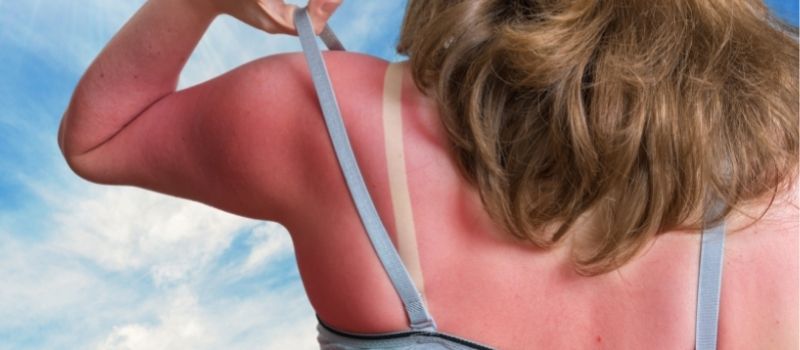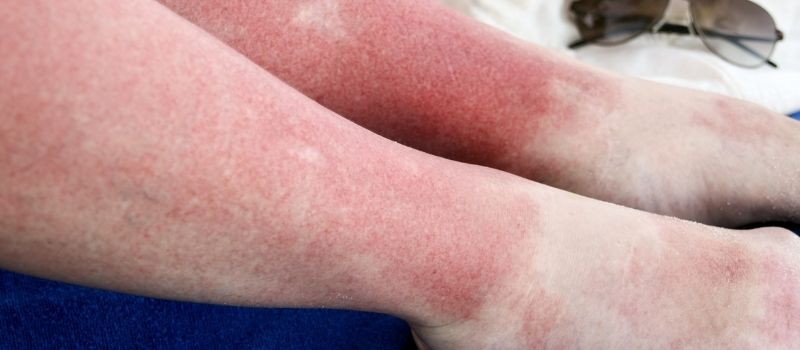Catching some sun rays can be a pleasant and therapeutic experience with its own health benefits.
The sun is your best source of vitamin D and as we know, vitamin D is a super important nutrient needed for the health of teeth and bones.
But besides the health benefits and the pure bliss we experience when we’re enjoying its warmth, there is no denying the sun can have a detrimental effect on our skin and can cause quite a lot of damage that can be very difficult to reverse.
If you are currently dealing with sun damage, below I will teach you how to reverse sun damage on your skin as well as discuss the best skincare ingredients for sun-damaged skin.
Towards the end, I will also show you what sun damage looks like, as well as answer a few other related sun-damage-related questions.

5 Best Treatments For Sun-Damaged Skin
Here are five best treatments for sun-damaged skin (explained below) you can add to your daily routine for some amazing results:
Glycolic acid
Glycolic acid is a naturally occurring substance that is most often found in exfoliating skincare products such as:
- cleansers
- toners
- moisturizers, and
- face masks.
It is an Alpha hydroxy acid with the smallest molecule size, which means that it can be easily absorbed by the skin due to its small size.
Glycolic acid is a water-soluble acid that acts by loosening the bonds between the dead skin cells and peel them away to provide good exfoliation of the upper skin layer with minimal irritation and it is very helpful when it comes to targeting skin concerns such as hyperpigmentation, fine lines, wrinkles, and dehydration.
Lactic acid
Lactic acid is another alpha hydroxy acid commonly found in skincare products and this substance is derived from lactose in milk.
Like glycolic acid, lactic acid is also known to have powerful exfoliating and anti-aging benefits, however, lactic acid has a bigger molecular size which makes it easily tolerable by the skin and it is known to be less irritating and more moisturizing than glycolic acid.
Lactic acid can help you target skin concerns such as pigmentation, sensitivity, irritation, dryness, fine lines, and wrinkles.
Retinol
Retinol is a vitamin A derivative that is the gold standard in anti-aging skincare.
It is known for its rejuvenating properties and it is also super useful when it comes to targeting sun-damaged skin, hyperpigmentation, fine lines, wrinkles, dull complexion, and uneven skin tone.
Be sure to read my full article on when and how to add retinols in your daily routine.
Azelaic Acid
Azelaic acid is an ingredient that can be found in wheat, rye, and barley, but it can also be synthetically made in a lab, which is the case when it comes to being used in skincare products due to its effectiveness and stability.
Azelaic acid can diminish the appearance of skin blemishes, help fade post-acne redness, pigmentation, and other discoloration, refine the skin’s surface, and reveal a brighter and more even complexion among other actions.
The reason why it suddenly became loved and respected by everyone is that azelaic acid is not an irritating ingredient and is fairly tolerable by all skin types, including sensitive and compromised skins.
Here are the two most popular azelaic acid products I recommend.
Vitamin C
An absolute favorite and loved by everyone, this ingredient is probably the most studied and recommended antioxidant on the market.
Vitamin C promotes collagen production and it helps in fading of mild dark spots and besides this, it’s s a powerful antioxidant against free radicals caused by the sun rays amongst other things.
Unlike vitamin A, it is recommended to apply vitamin C during the morning routine as it helps to protect your skin from sun damage.
What Does Sun Damage On Skin Look Like?
There are quite a few types of sun damage, so let’s begin by addressing them from the mildest up to the most severe one:
Suntan

Although a golden tan looks amazing on the skin, darkened skin as a result of tanning is the number one sign of damage to the skin.
Suntan happens when exposure to UV rays increases the production of the brown pigment melanin produced by melanocytes which are cells living in the deepest layer of the epidermis (stratum basale).
UV rays trigger the melanocytes into overdrive where they start to produce melanin in excessive amounts in order to protect our skin from burning and this ultimately puts you at risk of getting skin cancer.
Sunburn (I, II degree)
What’s worse than having a sunburn while you’re on your holiday? It’s pretty horrible, right? Well, your skin agrees with you on this one.
Sunburns can be grouped into two types: 1st and 2nd-degree sunburns and neither of these are pleasant.
First-degree sunburns mean that there is an actual thermal burn to the outer layer of your skin and this is the less severe category, however, second-degree sunburns can lead to blisters on the skin which are usually very painful and it is recommended to seek medical care if you develop blisters on your sunburn skin.
Talk about a pleasant holiday right there, huh?
Rosacea
Rosacea is a skin condition similar to acne that can be triggered by eating certain foods, using bad skincare products, consuming excessive amounts of alcohol, and, you guessed it: extremes of temperatures such as exposure to strong winds or excessive sun exposure.
Excessive sun exposure can damage the small blood vessels under your skin, particularly the cheeks and nose area, so when you blush and flush, these blood vessels can easily break and release fluid that can cause red blotches and bumps on your face.
Rosacea is a common condition and while it can be kept under control with the proper care, once it appears, there is no remedy that will help you completely get rid of it.
Premature lines and wrinkles
This is the main concern of many people that are not using adequate sun protection as the UV rays have the ability to penetrate deeper into the skin and break down the proteins that hold collagen and elastin together.
This will, in turn, result in the loosening of skin as well as the appearance of premature fine lines and wrinkles.
Uneven skin tone
This goes back to the above-mentioned melanin production because the skin, in order to protect itself from burning, will increase its production of the brown pigment melanin that’s responsible for getting a suntan.
However, in some cases, there can be some sort of a “defect” so to say due to the melanocytes being stressed into producing more pigment and this will lead to uneven melanin deposits, which will cause irregular coloring (pigmentation) of the skin.
This could lead to freckles, hyperpigmented spots, melasma, dark patches, and grey-ish, uneven patches and areas of the skin.
Age spots (Lentigo)
Age spots or solar lentigines are harmless brown spots that appear on areas of the skin that have been excessively exposed on the sun. It is most common on the hands, face, and neck, and while it mostly appears in people over the age of 40, younger people can get it too.
It is also a “defect” that happens when UV radiation causes the pigmented cells melanocytes in the skin to multiply and rapidly produce excessive amounts of the brown pigment melanin in order to protect the skin from burning.
Lentigo, while completely benign and harmless, can easily spread on the skin and get bigger and even darker in most cases.
Basal cell carcinoma
Basal cell carcinoma is the most common form of cancer and it is the easiest type to treat.
However, this can also be easily prevented by using adequate sun protection when outside and minimizing sun exposure, instead of having to treat it once it happens.
Basal cell carcinoma spreads slowly and it manifests itself in the form of a tumor that can take on many forms, including a pearly white or waxy bump often with visible blood vessels or flat, scaly, and flesh-colored or brown patch and it typically appears on the ears, neck, and face but it can also grow on the back, chest, or legs.
This form of cancer is caused by DNA damage to the cell triggered by exposure to UV radiation as this can trigger changes in the basal cells situated in the basal layer of the outermost layer of the skin, resulting in abnormal growth.
Melanoma
Melanoma is the most dangerous form of skin cancer and, yes, melanoma can kill you.
This form of cancer starts in melanocytes which are the cells responsible for producing the brown pigment melanin that gives us our suntan.
Melanocytes are situated in the deepest layer of the epidermis and excessive sun exposure without adequate protection can cause the cells to grow out of control and deposit abnormal amounts of melanin, leading to cancer.
Related Questions:

Is Skin Damage Reversible?
Some skin damage like hyperpigmentation, premature lines, wrinkles, and uneven skin tone are reversible and can be diminished by using the right skincare products or by undergoing professional procedures.
However, instead of trying to reverse the damage on your skin done by the sun, it is always best to prevent it and not have to deal with it in the first place.
The easiest way to prevent sun damage on the skin is to use adequate sun protection and minimize sun exposure.
Is Sun-Damaged Skin Permanent?
Some skin damage caused by the sun can be permanent.
For example, hyperpigmentation, wrinkles, and fine lines can stay on the skin permanently if not taken care of by using adequate skincare products or undergoing professional procedures.
These often have the potential to spreading or becoming darker the more neglected they are. Skin cancers, on the other hand, will leave a scar once they are removed from the skin by a doctor.
Sun damage is something that is much easier to prevent than to treat, so it is always a better idea to protect your skin by minimizing sun exposure and wearing adequate sun protection instead of having to deal with the consequences.

My name is Simone and I am a certified skin specialist. I created this website to teach my readers how to take great care of their skin and I also like to occasionally share my honest opinions on skincare products I’ve tried. You can learn more about me here.

You’re so right – prevention is so much easier than cure! Unfortunately, many people don’t think about protecting their skin until some level of damage is done, so it’s great to know that all is not lost and some of the signs can be treated.